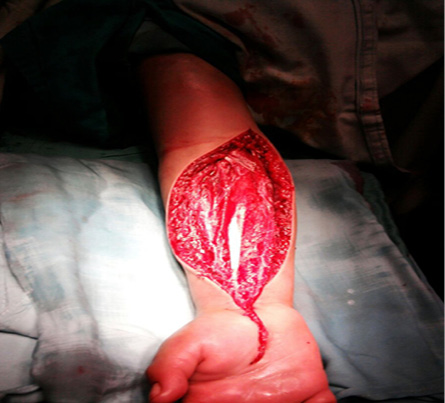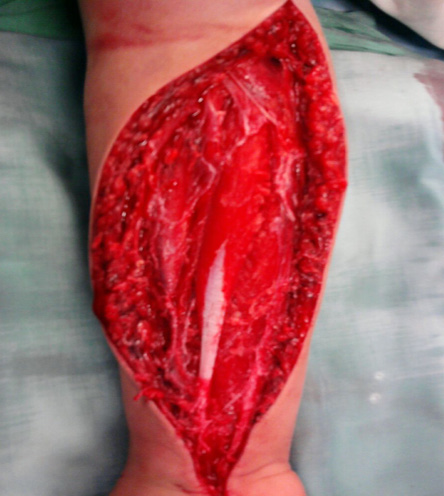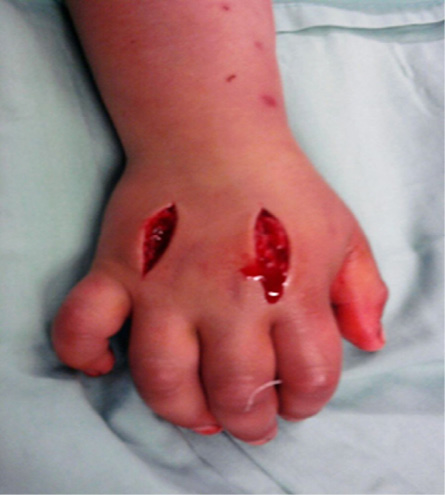Snake bites envenomation is not uncommon in Oman. Most of the snakes belong to the Viperidae (vipers) family. Its venom produces cytotoxic and hemorrhagic effects.1 The cytotoxic effects result in vascular endothelial damage with resultant early diffuse edema associated with local tissue necrosis and hypotension. Its systemic effects result in hemorrhage and coagulopathy.1 Local effects require regular monitoring for early recognition of compartment syndrome in which pressure builds up in the legs, abdomen, or arms, damaging tissue. The diagnosis of acute compartment syndrome is based on clinical judgment, as there are no distinct guidelines on threshold compartment pressure and fasciotomy.2
CASE REPORT
A five-year-old girl was admitted to the pediatric intensive care unit of Nizwa Regional Referral Hospital, eight hours after being bitten by a snake on the radial aspect of her right wrist. Her parents had used traditional local treatment in the form of application of local herbal paste along with application of proximal tourniquet (compression) prior to coming to hospital.
On admission, the patient had a Glasgow coma scale of 15 (out of 15), body temperature of 37.7°C, heart rate of 100beats/min, blood pressure 77/46mmHg, and an oxygen saturation of 98%. Local examination showed two fang marks above the radial styloid process of the right wrist with significant right upper limb edema. Extending over the hand and forearm along with pallor, bruising and tenderness. Distal pulses were feeble, and capillary refill of the fingers was delayed. Both active and passive finger movements were painful. As the child was irritable and frightened, it was difficult to assess for any hypoesthesia or paraesthesia. The severity of envenomation was graded as three.

Figure 1: Fasciotomy of forearm and carpal tunnel decompression of the right wrist.

Figure 2: Post fasciotomy wound right forearm.

Figure 3: Fasciotomy of right dorsum hand.
Venous access was established and 0.9% normal saline infusion was started immediately along with local wound cleaning and tetanus prophylaxis. Blood work reports were as follows: hemoglobin 9.3gm/dL, total white blood cell count 18000/L, and platelets 33000/L. Renal and liver function tests were within normal limits. Coagulation parameters were deranged activated partial thromboplastin time 180 seconds (normal=33s), international normalised ratio 10 (range=0.5–1.2), prothrombin time 180 seconds (range=10.2–11.9s). Her urine examination was normal and an electrocardiogram showed sinus tachycardia. She was administered 10 vials of anti-snake venom immediately on admission and her hypotension situation improved after initial fluid compensation. Over the next six hours swelling extended to the arm, axilla, and chest wall. Her radial pulse was feeble and her fingers started to get dusky and cold compared to the contralateral left upper limb. The frightened child was crying and it was difficult to assess whether there was significant stretch pain on passive finger extension. Due to non-availability of equipment, no intracompartmental pressure measurement was done. Diagnosis of compartment syndrome with the indication of fasciotomy was based on clinical findings in the affected area of pallor, pulseless, pain, color change of the fingers, and increased swelling. The patient received a further five units of anti-snake venom along with blood and fresh frozen plasma.
Under general anesthesia fasciotomy was performed with incision on volar aspect of right forearm, carpal tunnel [Figure 1 and 2] and dorsum of hand [Figure 3]. The forearm muscles were swollen with scattered patches of duskiness, which were excised. After one week postoperative pain and swelling diminished, and she then underwent secondary closure of the wounds. The patient was followed-up for six months postoperatively and achieved full, functional recovery.
DISCUSSION
Snake bite envenomation produces local and systemic effects due to the presence of proteases, hyaluronidases, and peptides in the venom.2 Forty-eight percent of bites occur on the feet and 52% on the hands,1 death can occur between six and 60 hours after a bite.2 Systemic effects appear within minutes include hypotension and victims may faint and children, in particular, become drowsy or semiconscious. Locally, there is increased vascular permeability allowing fluid accumulation and increased fluid pressure within the limited space, which if not treated can compromise vascularity leading to ischemic contracture and the worst outcome, amputation. Snake bites on the hand lead to early systemic manifestations due to its rich vascularity and the skin over the dorsum of hand being very thin.3
There is controversy as to when to proceed to fasciotomy in the treatment of compartment syndrome secondary to snake bite especially in children who can be uncooperative, irritable, and frightened. Measurement of intracompartmental pressure (ICP) may be helpful in such cases, but most of the centers in this part of world do not have the necessary equipment for measuring ICP. Therefore, it is not recommended to measure ICP when the diagnosis is clinically evident.4 The key sign of compartment syndrome development is pain out of proportion to patient’s clinical presentation.
Fasciotomy following a snake bite is rarely indicated but should be considered when clinically significant pressures (>30mm Hg)4 are present despite all supportive measures and adequate anti-snake venom therapy.5 Adopting this protocol will help in preventing long-term morbidity and limb loss.
Conclusion
In summary, snake bitten limbs, although not uncommon in this country, need constant monitoring in a hospital setting for any evolving systemic and local complications. Early surgical intervention may prove to be limb saving. The use of proximal tourniquets following snake bites should be discouraged and awareness of this needs to be raised in the population through health education. Patients should also be informed about the prognosis of recovery following fasciotomy and understand the importance of follow-up and rehabilitation.
Disclosure
The author declared no conflicts of interest.
references
- Evers LH, Bartscher T, Lange T, Mailander P. Adder bite: an uncommon cause of compartment syndrome in northern hemisphere. Scand J Trauma. Resusc and Emerg Med. 2010;18:50.
- Cawrse NH, Inglefield CJ, Hayes C, Palmer JH. A snake in the clinical grass: late compartment syndrome in a child bitten by an adder. Br J Plast Surg 2002 Jul;55(5):434-435.
- Hamdi MF, Baccari S, Daghfous M, Tarhouni L. Upper limb compartment syndrome after an adder bite: a case report. Chin J Traumatol 2010 Apr;13(2):117-119.
- Tiwari A, Haq AI, Myint F, Hamilton G. Acute compartment syndromes. Br J Surg 2002 Apr;89(4):397-412.
- Anil AB, Anil M, Karaarslan U, Bal A, Aksu N. Compartment syndrome in a child following Snake bite. Nobel Med 2010;6(3):108-111.